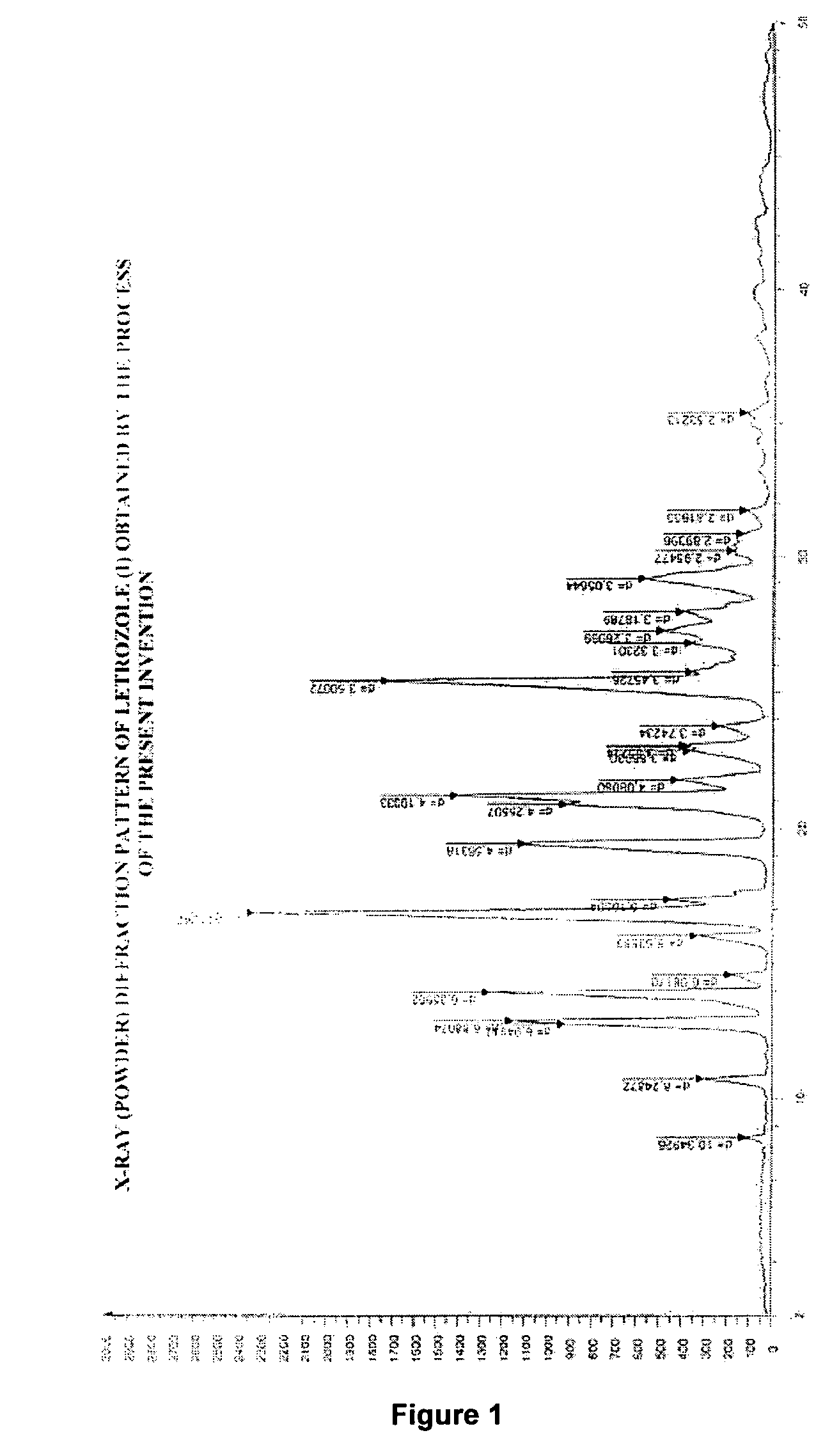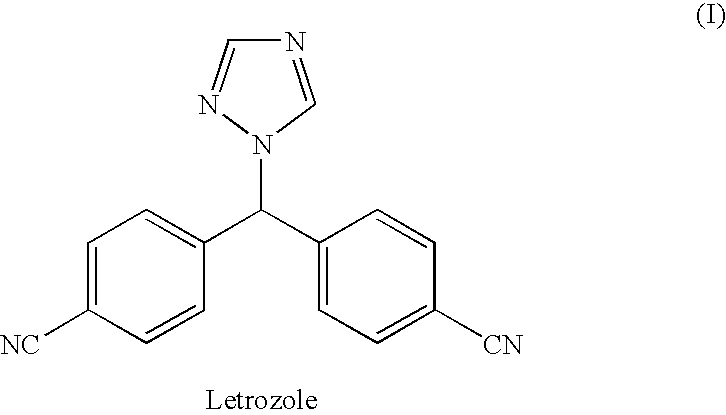Process for preparation of letrozole and its intermediates
a technology of letrozole and intermediates, applied in the field of improvement, to achieve the effect of high yield and purity, simple, convenient, economical and industrially viable process
- Summary
- Abstract
- Description
- Claims
- Application Information
AI Technical Summary
Benefits of technology
Problems solved by technology
Method used
Image
Examples
reference example-1
Preparation of 4-(1H-1,2,4-triazol-1-ylmethyl)benzonitrile hydrochloride (VII) through addition of 1H-1,2,4-triazole in one lot
[0163]To a solution of 4-bromomethyl benzonitrile (II, 500 gm; 2.5 mol) in acetone (2.5 Lt) was added potassium carbonate (528 gm; 3.82 mol) and the mixture was maintained at a temperature of 25° to 30° C. for 30 minutes under agitation. The temperature was raised to 45° to 50° C., and to the mixture was added 1H-1,2,4-triazole (III, 176 gm; 2.55 mol) in one lot in about 2 minutes time and the reaction mixture was thereafter heated under agitation at a temperature of 50° to 55° C., for 3 hours, when the reaction was found to be complete. The reaction mixture was cooled to room temperature and filtered to remove the insoluble potassium carbonate. The filter bed was washed with acetone (250 ml) and the filtrate was evaporated to dryness under reduced pressure. The residue was dissolved in ethyl acetate (3 Lt) and washed successively three times with water (4 L...
reference example-2
Preparation of 4-(1H-1,2,4-triazol-1-ylmethyl)benzonitrile hydrochloride (VII) through addition of 1H-1,2,4-triazole in one lot
[0164]To a solution of 4-bromomethyl benzonitrile (II, 500 gm; 2.5 mol) in toluene (2.5 Lt) was added potassium carbonate (528 gm; 3.82 mol) and the mixture was maintained at a temperature of 25° to 30° C. for 30 minutes under agitation. To the mixture was added 1H-1,2,4-triazole (III, 176 gm; 2.55 mol) in one lot in about 2 minutes time and the temperature was raised to 105° to 110° C., and the reaction mixture was thereafter heated under agitation at a temperature of 105° to 110° C., for 3 hours, when the reaction was found to be complete. The reaction mixture was cooled to room temperature and filtered to remove the insoluble potassium carbonate. The filter bed was washed with toluene (250 ml) and the filtrate was evaporated to dryness under reduced pressure. The residue was dissolved in ethyl acetate (3 Lt) and washed successively three times with water ...
example-1
Preparation of 4-(1H-1,2,4-triazol-1-ylmethyl)benzonitrile ydrochloride (VII) Through Addition of 1H-1,2,4-triazole in 1 to 4 Hours
[0165]To a solution of 4-bromomethyl benzonitrile (II, 500 gm; 2.5 mol) in acetone (2.5 Lt) was added potassium carbonate (528 gm; 3.82 mol) and the mixture was maintained at a temperature of 25° to 30° C. for 30 minutes under agitation. The temperature was raised to 45° to 50° C., and to the mixture was added 1H-1,2,4-triazole (III, 176 gm; 2.55 mol) in slowly in lots over 3 hours at the same temperature. After the complete addition, and the reaction mixture was thereafter heated under agitation at a temperature of 50° to 55° C., for 3 hours, when the reaction was found to be complete. The reaction mixture was cooled to room temperature and filtered to remove the insoluble potassium carbonate. The filter bed was washed with acetone (250 ml) and the filtrate was evaporated to dryness under reduced pressure. The residue was dissolved in ethyl acetate (3 L...
PUM
| Property | Measurement | Unit |
|---|---|---|
| temperature | aaaaa | aaaaa |
| temperature | aaaaa | aaaaa |
| temperature | aaaaa | aaaaa |
Abstract
Description
Claims
Application Information
 Login to View More
Login to View More - R&D
- Intellectual Property
- Life Sciences
- Materials
- Tech Scout
- Unparalleled Data Quality
- Higher Quality Content
- 60% Fewer Hallucinations
Browse by: Latest US Patents, China's latest patents, Technical Efficacy Thesaurus, Application Domain, Technology Topic, Popular Technical Reports.
© 2025 PatSnap. All rights reserved.Legal|Privacy policy|Modern Slavery Act Transparency Statement|Sitemap|About US| Contact US: help@patsnap.com



